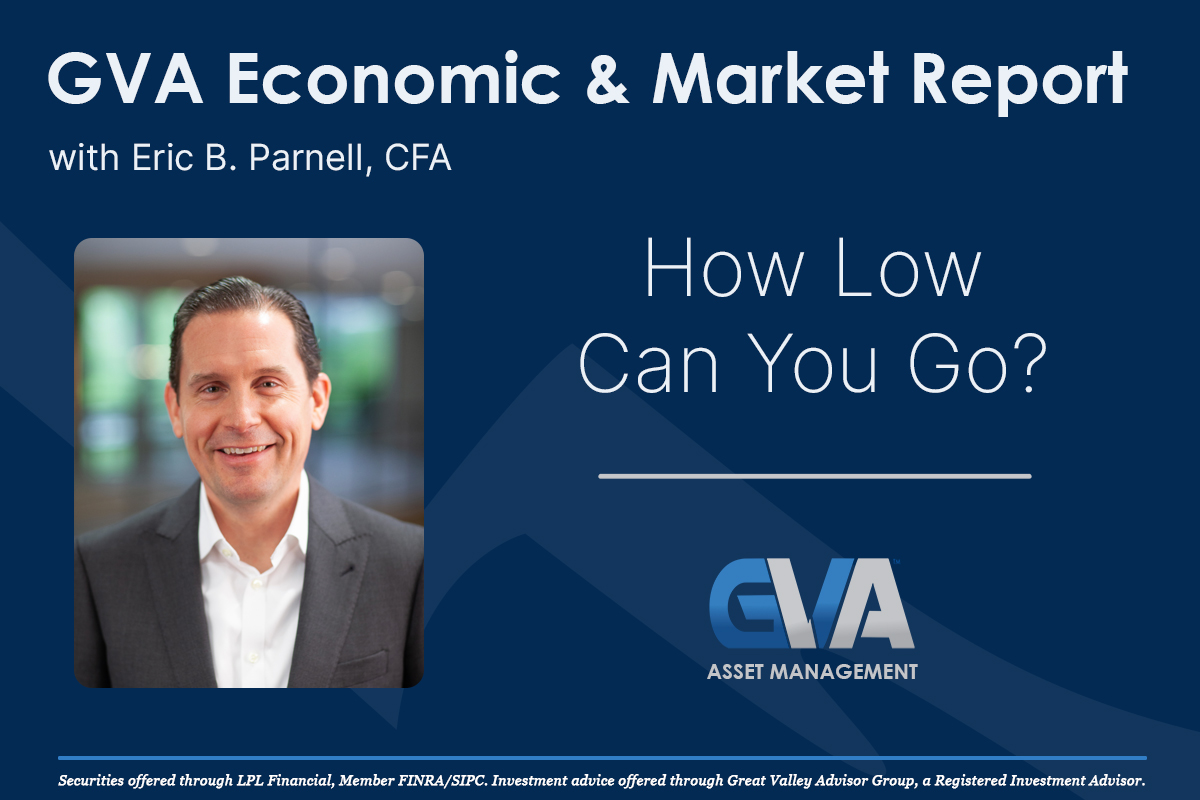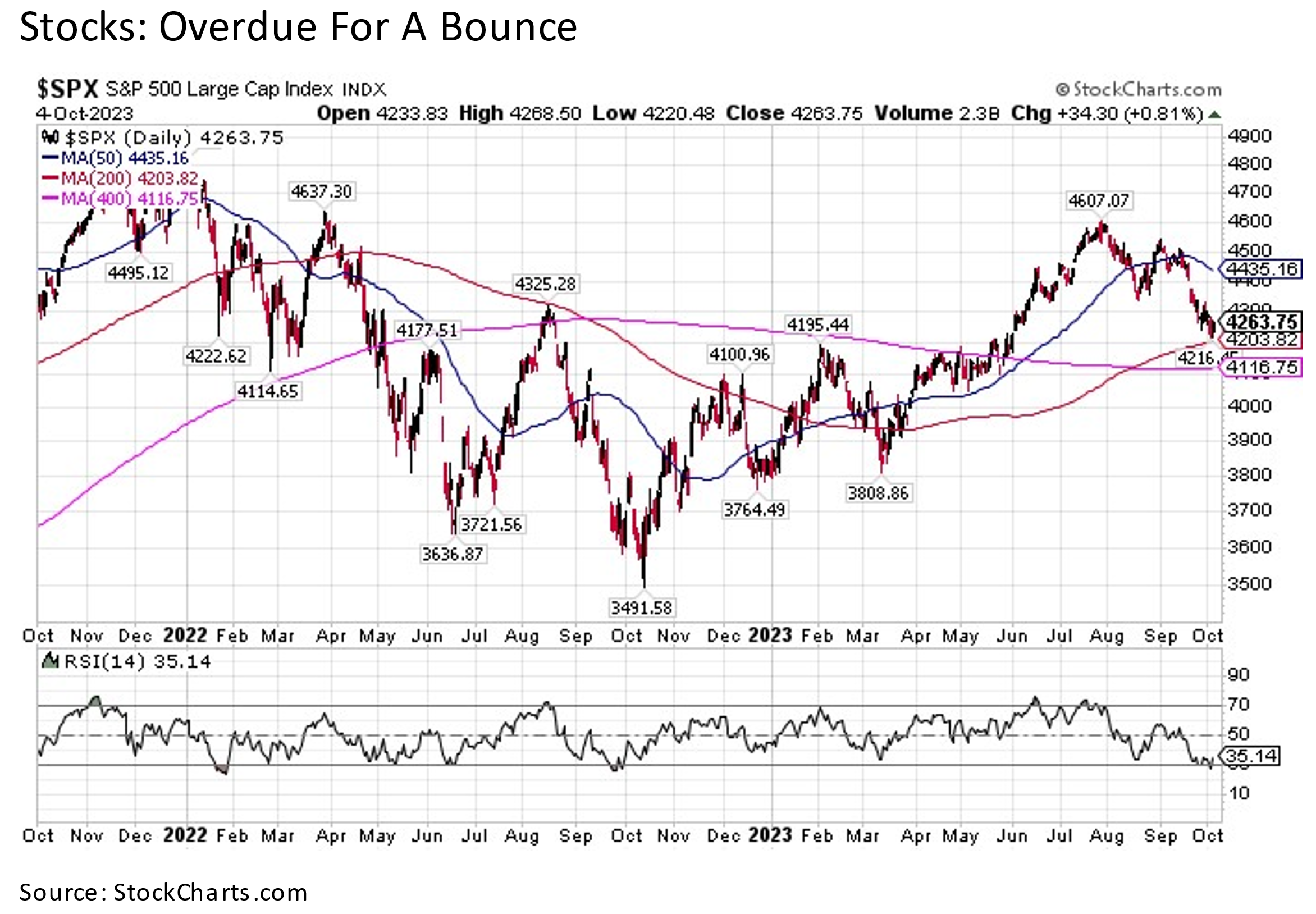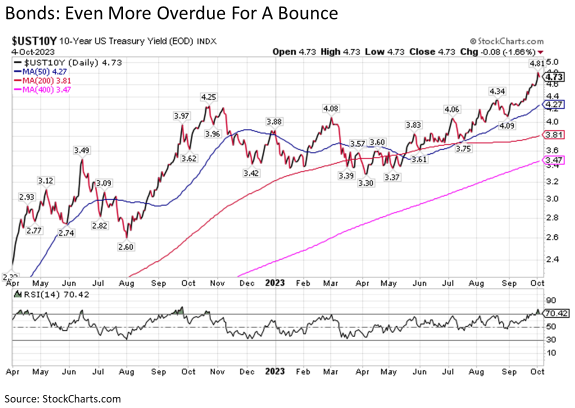
The period from mid-August to mid-November is a notorious time of year for capital markets. The pithy investment strategy “Sell in May and go away” is based on the idea of avoiding this stretch of time of year in stocks and picking back up after Halloween. And 2023 has been no exception in this regard. While U.S. stocks had a rousing summer through the end of July, the more than two months since have been particularly rough not only for stocks but even more so for bonds. How much lower should we reasonably expect stocks and bonds to go from here?
Stocks are overdue for a bounce. U.S. stocks were hanging in there for a while. Despite peaking at the end of July, the S&P 500 was only marginally lower through mid-September. But things suddenly turned dark during the last few weeks of the third quarter. Driven lower in part by a market that seemingly finally woke up to the fact after the latest FOMC meeting that the Fed actually intends to keep interest rates higher for longer (like they have been saying for the better part of a year now but the market seemingly wanted to ignore), the S&P 500 has now fallen by more than -8% peak-to-trough from its late July highs.

So how much lower should we expect stocks to go? Stocks are now overdue for at least a short-term bounce. The S&P 500 had gotten waaaaay ahead of itself following the blistering summertime rally, which is evidenced in the chart above by how far the index was trading above its 200-day moving average (the smooth red line in the chart above). The pullback over the past two months has brought U.S. stocks all the way back to earth at this same upward sloping 200-day moving average support.
Healthy clearing of the froth. Thus, the recent correction in stocks has all of the looks of a healthy consolidation and regression to the longer-term uptrend mean that is still well above where we were trading back in March during the outbreak of the banking crises and the market bottom from roughly one year ago in October 2022. And with stocks now trading at -2 standard deviations below its short-term 20-day moving average trend line at oversold readings according to its Relative Strength Index (that’s the near 30 reading on the slim chart below the larger price chart above), a short-term bounce on the S&P 500 from near 4200 to the 4350 to 4425 range in the coming weeks would not be unreasonable.
Lingering downside risks. It is important to note, however, that we remain near the dead center of the historically turbulent mid-August to mid-November period. And we are not without forces such as spiking U.S. Treasury yields, steadily tightening monetary policy, ongoing policy uncertainty out of Washington DC, and signs of ongoing liquidation activity from China just to name a few that could still bat stocks back to the downside over the next four to six weeks following any short-term bounce. The key will be to watch whether key technical support levels hold such as the upward sloping 200-day moving average, the upward sloping trendline from the October 2022 lows, and the slowly upward turning 400-day moving average (the pink line in the chart above).
Constructive fundamentals. The good news is that the fundamental outlook for stocks remains constructive looking beyond the coming weeks through the end of 2023 and beyond. Yes, valuations on the S&P 500 Index still look a bit frothy at 23.7 times trailing 12-month GAAP earnings, particularly with a 10-Year U.S. Treasury yield rising toward 5% in recent weeks. But the good news is that corporate earnings are now sustainably on the rise from the 2022 Q4 lows and corporate profit margins are increasingly expanding thanks to core inflation pressures continuing to subside. This helps make forward valuations on the broader market much more reasonable.
Pockets of attractive valuations. Let’s take the good news for stocks one step further with a look at valuations. While the headline S&P 500 index may still look pricey, stocks still offer a variety of wide and deep pockets of attractive value. This includes both U.S. mid-cap and U.S. small cap stocks trading at their most deeply discounted valuations in nearly three decades outside of the depths of the Great Financial Crisis. On a sector basis, while the technology (Apple, Microsoft, NVIDIA) and consumer discretionary (Amazon, Tesla) sectors continue to trade at their highest multiples in decades, many other sectors such as health care and industrials are trading at their lowest valuations in years. Looking outside of the U.S., we see that stocks across the developed and emerging world are trading at their widest discounts relative to the U.S. in decades.
Watch Treasury yields. The market outlook remains constructive despite short-term pressures. And while a bounce may be imminent, the potential for further short-term downside persists. A key reading to watch to determine when the stock market is likely to see some relief is the bond market in general and U.S. Treasuries in particular. If we think the U.S. stock market is oversold having retreated to its 200-day moving average, the U.S. bond market as measured by 10-year U.S. Treasuries is even more oversold.

Remember our discussion on the U.S. stock market being waaaaay ahead of itself by the end of July following its summertime surge? The same could be said even more so about the spike higher in U.S. Treasury yields today. Knowing that as yields rise, prices fall, the jump in the 10-year U.S. Treasury yield from 4.09% at the start of September to over 4.80% in recent days is a monster move, to say the least. This burst has taken the 10-year yield to “overbought” levels well above its 50-day and 200-day moving average trendlines. And just like the S&P 500 eventually regressed back to the mean of its 200-day moving average, the same should be expected of the 10-year U.S. Treasury yield in the weeks and months ahead. This is particularly true given that inflation, arguably the most important determinant of Treasury yields, continues to steadily come down from its 2022 peak. The fact that the 200-day moving average for 10-year Treasury yields is all the way back at 3.81% suggests that a meaningful bond market bounce could be seen in the short-term to intermediate-term before the end of the year.
Bottom line. It’s been a tough stretch for both stocks and bonds over the last couple of months. Could we see further declines in stocks and bonds in the coming days? Absolutely, as we are right in the heart of a historically tough time of year for capital markets. But the good news is that both stocks and bonds are now overdue for a bounce, and the even better news is that both underlying fundamentals and valuations support the sustainability of any such bounce through the remainder of the year and into 2024.
Disclosure: I/we have no stock, option or similar derivative position in any of the companies mentioned, and no plans to initiate any such positions within the next 72 hours. I wrote this article myself, and it expresses my own opinions. I am not receiving compensation for it. I have no business relationship with any company whose stock is mentioned in this article. Investment advice offered through Great Valley Advisor Group (GVA), a Registered Investment Advisor. I am solely an investment advisor representative of Great Valley Advisor Group, and not affiliated with LPL Financial. Any opinions or views expressed by me are not those of LPL Financial. This is not intended to be used as tax or legal advice. All performance referenced is historical and is no guarantee of future results. All indices are unmanaged and may not be invested into directly. Please consult a tax or legal professional for specific information and advice.
Tracking #485090-1
